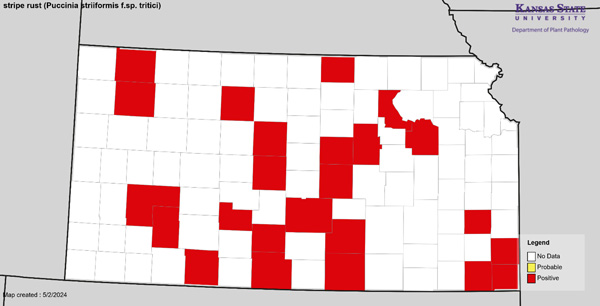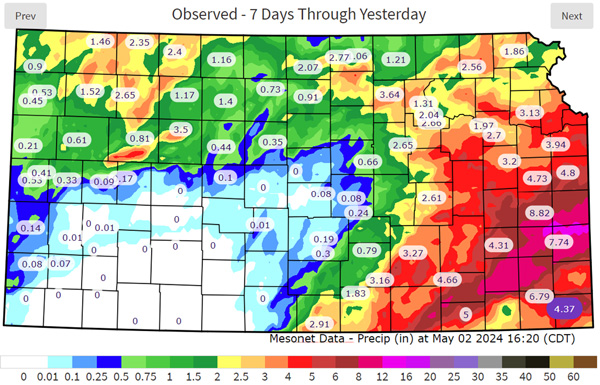Breadcrumb
- Home
- Wheat stripe rust update and fungicide considerations
Agronomy e-Update, May 2, 2024
The wheat crop is ahead of schedule and there is a dramatic difference in yield potential in parts of the state that have received moisture and parts that have not. Here, we review some key wheat fungicide considerations.
As of May 2, stripe rust has been detected in 24 Kansas counties. It’s important to note that most of these observations have been at very low or trace levels (Figure 1). You can keep up-to-date with reports here: https://wheat.agpestmonitor.org/. Up until this point, the disease has largely been limited by lack of moisture. Reports in the northwest portion of the state are most concerning, as the crop in this region is still in earlier growth stages, and there is ample time for stripe rust to take hold if the environment stays favorable. There are some counties where stripe rust has been detected on flag leaves at an elevated incidence. These fields should be carefully scouted and may be candidates for fungicide applications.
Because the crop is ahead of schedule, many regions in south and south central Kansas have moved past the window for a fungicide application. As a reminder, fungicides have pre-harvest intervals based on growth stages or the number of days before harvest. This publication lists some common fungicides and their pre-harvest intervals: https://bookstore.ksre.ksu.edu/pubs/ep130.pdf. It is always a good idea to consult the label prior to application.

Figure 1. Wheat stripe rust reports as of May 2, 2024 (https://wheat.agpestmonitor.org/). Reports are a collaborative effort between K-State Research and Extension, crop consultants, industry partners, and producers. Additional reports can be sent to andersenk@ksu.edu.
We are now fielding questions about the value of a fungicide application in fields that are between flag leaf and flowering growth stages. Here are some factors to consider as we make those decisions:

Figure 2. Precipitation observed over the past 7 days according to the Kansas Mesonet (https://mesonet.k-state.edu/). Areas that have received moisture may be at higher risk of stripe rust developing over the coming week.
Leaf rust has now been reported in Oklahoma but has not taken hold in Kansas. We will continue to monitor for it over the coming weeks.
Kelsey Andersen Onofre, Extension Plant Pathologist
andersenk@ksu.edu
